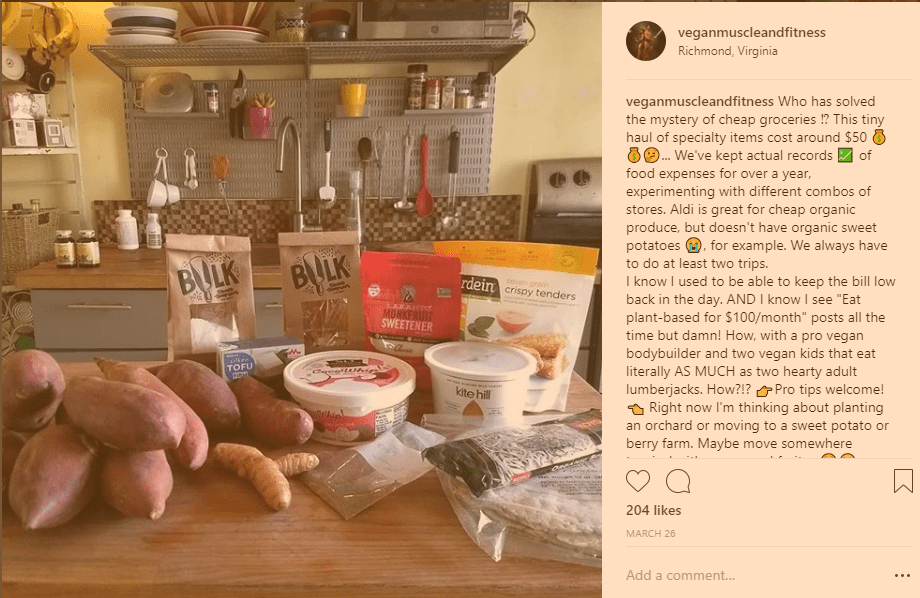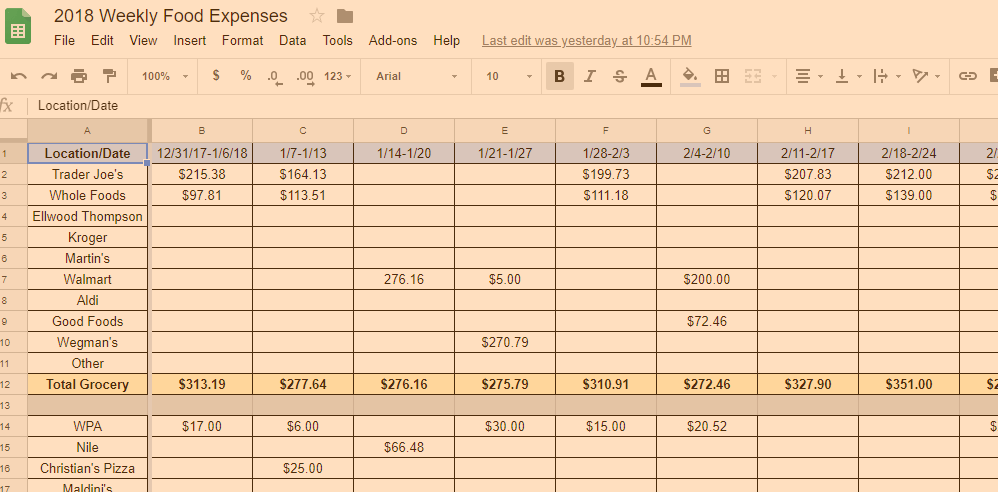
We eat a whole foods plant-based diet and, not only that, we eat a LOT. With pro vegan bodybuilder Derek consuming about 4000 calories a day, and two vegan kids that have invisible supplementary stomachs, it is a challenge to keep costs down (as a 36 year old active woman I eat a more reasonable 1800 calories/day or so).
I’ve seen all sorts of posts and even books about eating a super cheap vegan diet – and it can definitely be done! Rice and beans, for example, are staple foods for some of the lowest income populations on earth. We like to eat a lot of vegetables and fruit, though, and whenever I take a closer look at posts about eating vegan for $30 a month per person they tend to feature enriched pasta and things like that rather heavily. Vegan and whole foods plant based are not always synonymous.
I shared a post on Instagram recently seeking the answer to the mystery of cheap groceries:

and some commented that they feed a family of four for $60/week?! When they mentioned clipping coupons to do it, I knew I had to keep looking. Fruit and veggies pretty much never come with coupons! We spent nearly that much per week on sweet potatoes, dates, and bananas alone!
Luckily, we have two years of data that summarizes our plant based grocery bill as well as all restaurant expenses!

Over that time, we experimented with different (American) grocery stores (Trader Joe’s, Whole Foods, Aldi, Walmart, Wegmans, Kroger, natural foods stores), different staple menus, even meal prep services. And we’ve found that the secret to reducing the plant based grocery bill for our family of four that is not going to eat any damn less is…
- Grocery pickup at Walmart
- In store shopping at Aldi
- Ordering specialty items via Amazon Primenow, maybe bi-weekly
Why does it work? Partly because Walmart and Aldi are extremely cheap. Each of these chains is far from glamorous, but they carry a decent amount of organic produce and frozen vegetables that are far cheaper than you’ll find even at Trader Joe’s.
Back to that “far from glamorous” part – it’s the second key to spending less. In general, nobody wants to actually go IN Walmart. The lighting alone is claustrophobic, and taking children inside is like entering a black hole of time. We can never leave without visiting the toy section. Anyway, because we pre-order food online and pick it up by waiting in the parking lot for them to wheel out our stuff, we need never go in. Never going in means never buying superfluous crap on impulse. That alone has saved a ton of money.
Aldi is similar – what they carry is so limited anyway that it’d be hard to overbuy. And it’s like shopping in an abandoned warehouse that doesn’t lull me into buying more with soft lighting and exposed wood like Whole Foods does. Bonus: combining these two spots into one trip, where I stop by Walmart to pick up and then shop quickly in Aldi has cut down our shopping time to less than 1 hour. That’s pretty miraculous with two small children! All you have to do is make it not fun for anyone and it’s over so much more quickly! And cheaply.
Specialty items purchased have also been drastically reduced by using PrimeNow. I only get essentials and again, I don’t get excited about new vegan items at the natural foods store that I feel compelled to buy even though we don’t really eat fake cheese or whatnot. There is a small charge for delivery including tip but I feel this is offset by savings.
Next, just the act of tracking makes you more reluctant to overspend – it’s the same thing that works for finances in general. We were able to set a reasonable threshold for our food expenses, and then it was kind of fun to try to beat it.
The final key, that we constantly hammer into people that attend our talks and workshops is this: we eat almost the same thing daily and weekly. Sound boring? I think it’s exciting to not waste brain cells on figuring out what to eat. We are drowning in choices all day long and that is three or four fewer major decisions to have to make, so I’m sold.
More on what we buy in the next installment!




Marcella, thanks for the article. Here in Arlington, VA, neither Aldi nor Walmart is close by. However, I’m often out and about closer to a couple of Aldi’s so will now remember to stop in if I’m in the vicinity.
Cindy, I think Marcella is eating a wide variety of foods, but that the *structure* of the meals remains the same: “Within a week MEALS are roughly the same, but the components are various.” That might mean a smoothie with two fruits, one bean, etc. but those fruits and type of bean can vary within and across weeks. Marcella can correct me if I’m wrong.
I’m moving in more of a structured direction more for time savings. If I know morning is a smoothie, I don’t have to think much about that. I tend to repeat foods more within a week, so I may batch cook something with lentils or beans, so we eat it for dinner at least twice. I’m also cutting down on food waste, because I was finding I’d buy an ingredient for a single meal and then not have a way to use the rest of it, say using part of a can of beans.
That said, I think it is terrific that you are investing time in preparing healthy meals for your family. Obviously you were very well informed and bringing them the very best. If you are getting kids to eat healthy, you are doing awesome work for them and for the world.
Wow thank you for this informative post. My wife and I have a weekly grocery budget but we never really know how much we actually spent by the end of the month. Just by looking at the picture of the excel spreadsheet I see how easy it is to track grocery bills and be more conscious of food spending in order to work it into financial planning.
Awesome, I hope it helps you guys!
Thanks so much for your reply! I will look forward to seeing the details of your diet and meal plan in the next installment. We eat completely WFPB/no oil vegan and if we ate the same things every week, we would miss out on a lot of variety. Maybe it’s because we are only a family of 3. There are so very many different kinds of fruits and vegetables that I can’t see how one could possibly eat most of them in a week. Recently I went to a friend’s house and she introduced me to Jícama root, and I had never eaten that in my whole life! Despite the fact that I make a concerted effort to eat a variety, there’s just so much out there to explore. I recently listened to Dr. Bulsiewicz on the Plant Proof Podcast and the topic of building a healthy gut was absolutely fascinating. Of course I have read on the topic before, but there was a lot of new info I had never heard. For example I try to make many of my own probiotics via kombucha, vegan yogurt, saurkraut, etc. But there are so many of them above and beyond even that. Can you make and consume a variety of these all in one week? I mean I guess you could? kimchi, miso, tempeh, sourdough bread, olives, etc? Even the variety of beans and lentils that exist, how could you eat all of those in one week? Sure Gregor’s list is amazing and far and away above the SAD. Our family can do that without even trying, but getting an actual and real variety takes work! At least for me. 🙂
Thank you for the informative article. I’m not an expert, but I do read and listen to many of them. One thing that I have learned is that it’s beneficial for many reasons to eat a variety of plants. It may be easier to eat the same thing all the time, but there are healthy reasons that it is worth the time to make those extra decisions. I find that meal planning is the key. Yes, it takes extra time and decisions, but I think it’s worth while. Meal planning ensures that I buy only ingredients that I actually need and will use, which also saves a lot of money. Check out Dr. Bulsiewicz, or any of the well known plant based doctors (Fuhrman, Gregor, etc.), the message is the same. Eat a variety. 🙂
Thanks for your comment! We eat a very wide variety of plants within every week, but every week is basically the same. For example, our daily bean shake alone contains all of Dr. Greger’s daily dozen, even turmeric and amla in addition to several varieties of berries and several varieties of greens, cocoa powder, beans, etc. Every lunch is composed of a family sized salad bowl per person filled with a variety of fresh greens, salad toppings and herbs. Breakfast has a variety of fresh fruits and spices in addition to oatmeal, etc. Within a week MEALS are roughly the same, but the components are various, to clarify. We do follow recommendations from the plant-based docs and speak at a lot of the same events – in fact, Dr. Klaper attended our last meal planning talk and thanked us both afterward! Since I’m a researcher in chronic disease and Derek is certified in plant-based nutrition and we work with daily with clients, we consume as much nutrition research as is available before sharing our strategies, most definitely! The details of our diet will be in the next installment!